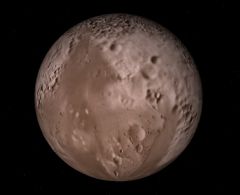Difference between revisions of "Naiad"
Jump to navigation
Jump to search
(Added gallery image.) |
(Corrected links.) |
||
| Line 61: | Line 61: | ||
<gallery> | <gallery> | ||
naiad-neptunezip.jpg|<center>Naiad from ''neptune.zip'' in Orbiter 2002</center> | naiad-neptunezip.jpg|<center>Naiad from ''neptune.zip'' in Orbiter 2002</center> | ||
| − | Neptune Trio.jpg|<center>Image of | + | Neptune Trio.jpg|<center>Image of Naiad, [[Thalassa]], and [[Despina]] from [[w:Voyager 2|Voyager 2]],<br>from Wikimedia Commons</center> |
Naiad Voyager.png|<center>[[w:Voyager 2|Voyager 2]] discovery image of Naiad in 1989,<br>Smearing due to spacecraft motion,<br>from Wikimedia Commons</center> | Naiad Voyager.png|<center>[[w:Voyager 2|Voyager 2]] discovery image of Naiad in 1989,<br>Smearing due to spacecraft motion,<br>from Wikimedia Commons</center> | ||
</gallery> | </gallery> | ||
Revision as of 11:59, 12 August 2024
Naiad (Neptune III, S/1999 N 6) is innermost known moons of Neptune. It was discovered Voyager 2 in September 1989. It is named after the naiads of Greek mythology.
Naiad in Orbiter
Naiad was first introduced into Orbiter with the add-on neptune.zip in November 2002.
| Add-on | Source | Version | Author | Type | Release Date | Compatibility | Wiki article |
|---|---|---|---|---|---|---|---|
| Neptune | AVSIM | Rolf Keibel | Scenery | 7 November 2002 | |||
Voyager 2 discovery image of Naiad in 1989,
Smearing due to spacecraft motion,
from Wikimedia Commons
:
| Neptune's natural satellites |
|---|
| Named satellites:
Despina | Galatea | Halimede | Hippocamp | Laomedeia | Larissa | Naiad | Nereid | Neso | Proteus | Psamathe | Sao | Thalassa | Triton Numbered Satellites: |
| See also: Pronunciation key | rings of Neptune |
| edit The Solar System | |
|---|---|
| Central star |
Sun (Sol) |
| Planets |
Mercury - Venus - Earth - Mars - Jupiter - Saturn - Uranus - Neptune |
| Natural satellites |
Moon - Phobos - Deimos - Io - Europa - Ganymede - Titan - more... |
| Add-ons |
Planets - Dwarf Planets - Small objects - Natural satellites - Alternative star systems |
 | This natural satellite related article is a stub. You can help Orbiterwiki by expanding it.
|



